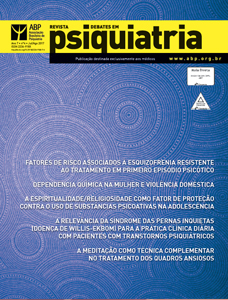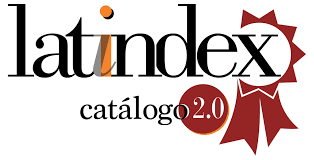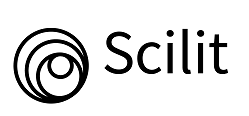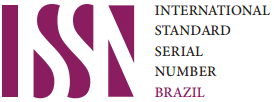Spirituality/religiousness as a protective fator against psychoactive substance use in adolescence
DOI:
https://doi.org/10.25118/2236-918X-7-4-3Keywords:
Adolescent, drug, substance abuse, spirituality, religiousness, protective factorsAbstract
Objective: To analyze the impact of spirituality and/or religiousness on the use of psychoactive substances in the adolescent population in both primary and secondary protection. Substance use, abuse or dependence cover interventions in a variety of areas: biological, psychic, social, and spiritual. Methods: Articles published in scientific databases between 2000 and 2015 were searched using the following keywords: adolescent, drug, substance abuse, spirituality, religious protection, religiousness. A total of 115 articles were retrieved from three databases (PubMed, BIREME, SciELO), and eight were selected taking into consideration the inclusion and exclusion criteria. Results: The studies point in the same direction, in that both spirituality and religiousness are of great importance for adolescents in relation to psychoactive substance use, abuse, and dependence. In addition to the protective factors mentioned above, others were also observed: family, friends, social group, environment, resilience, information, and future perspectives. Conclusion: Spirituality signals a broad connection between the individual and their environment, aiming at the well-being and personal growth of both theperson and their peers. The control of religion and/or the experience of spirituality act directly protecting the youth against involvement with substance use, as a result of its relation with self-regulation, psychological and social factors, availability of information on substance dependence and its consequences, and good family structure. In this scenario, the need to develop public policies with this approach is highlighted.
Downloads
Metrics
References
Rew L, Wong YJ. A systematic review of associations among religiosity/spirituality and adolescent health attitudes and behaviors. J Adolesc Health. 2006;38:433-42.
Ritt-Olson A, Milam J, Unger JB, Trinidad D, Teran L, Dent CW, et al. The protective influence of spirituality and “Health-as-a-Value” against monthly substance use among adolescents varying in risk. J Adolesc Health. 2004;34:192-9.
Bock AMB. A adolescência como construção social: estudo sobre livros destinados a pais e educadores. Psicol Esc Educ (Impr). 2007;11:63-76.
Schoen-Ferreira TH, Aznar-Farias M, Silvares EFM. Adolescência através dos séculos. Psicol Teor Pesq. 2010;26:227-34.
Stewart C. The influence of spirituality on substance use of college students. J Drug Educ. 2001;31:343-51.
Pratta EMM, Santos MA. Reflexões sobre as relações entre drogadição, adolescência e família: um estudo bibliográfico. Estud Psicol (Natal). 2006;11:315--22.
Duailibi S, Laranjeira R. Políticas públicas relacionadas às bebidas alcoólicas. Rev Saude Publica. 2007;41:839-48.
Lopes GM, Nóbrega BA, Del Prette G, Scivoletto S. Use of psychoactive substances by adolescents: current panorama. Rev Bras Psiquiatr. 2013;35:S51:61.
Pechansky F, Szobot CM, Scivoletto S. [Alcohol use among adolescents: concepts, epidemiological characteristics and etiopatogenic factors]. Rev Bras Psiquiatr. 2004;26:S14-7.
Panzini RG, Rocha NS, Bandeira DR, Fleck MPA. Quality of life and spirituality. Rev Psiquiatr Clin. 2007;34:105-15.
Sanchez ZM, Oliveira LG, Nappo SA. Fatores protetores de adolescentes contra o uso de drogas com ênfase na religiosidade. Cienc Saude Coleti va. 2004;:43-55.
Miller L, Davies M, Greenwald S. Religiosity and substance use and abuse among adolescents in the Nati onal Comorbidity Survey. J Am Acad Child Adolesc Psychiatry. 2000;39:1190-7.
George LK, Larson DB, Koenig HG, McCullough ME. Spirituality and health: what we know, what we need to know. J Soc Clin Psychol. 2000;19:102-16.
Tuguimoto JK, et al. A contribuição da espiritualidade e da religiosidade na prevenção e no tratamento da dependência química. Rev Cult UFPE Estud Universit. 2011;28:33-5.
Hanson GR. New vistas in drug abuse preventi on. Nida Notes. 2002;16:3-7.
De Micheli D, Fisberg M, Formigoni MLOS. Estudo da efeti vidade da intervenção breve para o uso de álcool e outras drogas em adolescentes atendidos num serviço de assistência primária à saúde. Rev Assoc Med Bras. 2004;50:305-13.
São Paulo. Lei 14.592, 19 de outubro de 2011. A bebida alcoólica pode causar dependência química e, em excesso, provoca graves males à saúde [Internet]. 2011 [cited 2015 Sep 15]. www.alcoolparamenoreseproibido.sp.gov.br/wpcontent/uploads/pl698a11-parcial.pdf
Unidade de Pesquisas em Álcool e Drogas (UNIAD), Insti tuto Nacional de Ciência e Tecnologia para Políti cas Públicas do Álcool e Outras Drogas (INPAD). II LENAD - Levantamento Nacional de Álcool e Drogas. Relatório 2012 [Internet]. [cited 2015 Jun 22]. inpad.org.br/wp-content/uploads/2014/03/Lenad-II-Relat%C3%B3rio.pdf
Figlie NB, Bordin S, Laranjeira R. Aconselhamento em dependência química. 2ª ed. São Paulo: Roca; 2010.
Piko BF, Kovacs E, Kriston P, Fitzpatrick KM. “To believe or not to believe?” Religiosity, spirituality, and alcohol use among Hungarian adolescents. J Stud Alcohol Drugs. 2012;73:666-74.
Ano GG, Vasconcelles EB. Religious coping and psychological adjustment to stress: a metaanalysis. J Clin Psychol. 2005;61:461-80.
Salas-Wright CP, Olate R, Vaughn MG. Religious coping, spirituality, and substance use and abuse among youth in high-risk communiti es in San Salvador, El Salvador. Subst Use Misuse. 2013;48:769-83.
Amparo DM, Galvão ACT, Alves PB, Brasil KT, Koller SH. Adolescentes e jovens em situação de risco psicossocial: redes de apoio social e fatores pessoais de proteção. Estud Psicol (Natal). 2008;13:165-74.
Good M, Willoughby T. Insti tuti onal and personal spirituality/religiosity and psychosocial adjustment in adolescence: concurrent and longitudinal associati ons. J Youth Adolesc. 2014;43:757-74.
Wills TA, Yaeger AM, Sandy JM. Buff ering eff ect of religiosity for adolescent substance use. Psychol Addict Behav. 2003;17:24-31.
Messias GP. A parti cipação da genéti ca nasdependências químicas. Rev Bras Psiquiatr. 1999;21:35-42.
Downloads
Published
How to Cite
Conference Proceedings Volume
Section
License

This work is licensed under a Creative Commons Attribution-NonCommercial 4.0 International License.
Debates em Psiquiatria allows the author (s) to keep their copyrights unrestricted. Allows the author (s) to retain their publication rights without restriction. Authors should ensure that the article is an original work without fabrication, fraud or plagiarism; does not infringe any copyright or right of ownership of any third party. Authors should also ensure that each one complies with the authorship requirements as recommended by the ICMJE and understand that if the article or part of it is flawed or fraudulent, each author shares responsibility.
Attribution-NonCommercial 4.0 International (CC BY-NC 4.0) - Debates em Psiquiatria is governed by the licencse CC-By-NC
You are free to:
- Share — copy and redistribute the material in any medium or format
- Adapt — remix, transform, and build upon the material
The licensor cannot revoke these freedoms as long as you follow the license terms. Under the following terms:
- Attribution — You must give appropriate credit, provide a link to the license, and indicate if changes were made. You may do so in any reasonable manner, but not in any way that suggests the licensor endorses you or your use.
- NonCommercial — You may not use the material for commercial purposes.
No additional restrictions — You may not apply legal terms or technological measures that legally restrict others from doing anything the license permits.






























